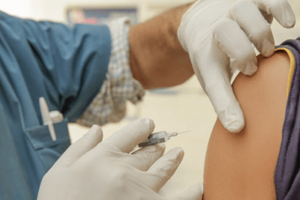
Rabies is one of the most common zoonotic diseases (transmitted from animals to humans) in Egypt.
It causes a significant number of deaths every year due to citizens’ unawareness of how to deal with a dog bite.
So, read along to learn more about this disease, its causes, and ways to deal with it.
What is Rabies?
It is a zoonotic disease caused by a virus that infects the central nervous system of mammals.
Rabies is usually transmitted when an animal bites another animal or human.
The virus starts at the site of the bite, travels through the nerves until it reaches the brain, and once it arrives, symptoms begin to appear.
Death often occurs within a week of symptoms appearing.
What causes rabies?
Infection occurs due to the rabies virus, present in the saliva of infected animals.
It is transmitted to humans by; biting, scratching, or licking an open wound.
Animals that may transmit the rabies virus
All mammals may carry this virus, such as:
- Pets: dogs and cats.
- Farm animals: cows, goats, camels, and horses.
- Wild animals: bats, raccoons, foxes, mongooses, and jackals.
Rabies disease in dogs and cats
The infection is transmitted between dogs or cats through; biting or licking open wounds.
The infection is most often transmitted to dogs or cats by; bats and raccoons.
The virus also enters the bloodstream and then travels to the nervous system.
It is also worth noting that camel rabies is quite common in countries where camel breeding is widespread, such as Saudi Arabia.
Symptoms of rabies in dogs and cats
The incubation period in cats ranges from several weeks to a year of exposure to the virus.
While the incubation period in dogs is (21-80) days after exposure, noting that it may be slightly longer or shorter.
Symptoms include;
- The animal becomes agitated or irritable.
- Some physical signs appear, such as;
- Fever.
- Excessive salivation.
- Difficulty swallowing.
- Ataxia and seizures that may reach paralysis.
- As the infection progresses, some symptoms appear, such as; Extreme sensitivity to light, movement, or sound, with a preference for dark and quiet places.
- The appearance of foam in the mouth, this foam may not appear, while drooling only increases.
- Increased seizures and lack of muscle control, leading to the inability to breathe, and hence death.
Diagnosis and treatment in animals
A veterinarian cannot confirm the diagnosis with blood tests.
A definite diagnosis is a biopsy of brain tissue, but it can only be done after the animal has died.
Further, If symptoms appear on the animal, it cannot be treated.
However, the veterinarian disposes of it by euthanasia; To prevent the spread of the virus.
Also, if your dog or cat is bitten by; a wild animal; The vet will give it a rabies shots to reduce the possibility of infection.
Rabies in humans
Infection in humans is rare but very dangerous.
It affects the central nervous system and is often fatal if not treated before symptoms appear.
Rabies is ubiquitous, especially in Asia, Africa, and Central and South America.
What do you do if you got bitten by a dog or animal that you suspect has rabies?
This condition is called: “Post-Exposure Prophylaxis” to prevent the virus from spreading to the nervous system.
Prophylactic measures include the following;
- Immediately wash the wound for at least 15 minutes using soap and water or other detergents.
- Disinfect the wound with an antiseptic containing iodine or alcohol.
- Start taking the vaccine doses quickly, as you need four doses over a month; If you have never had a previous vaccination or only two doses if you have had one before.
- Take the Rabies Immunoglobulin: This is done by; injecting inside and around the wound to provide immediate but short-term protection from infection.
- Quickly report the rabid animal.
Symptoms in humans
The incubation period is usually between 2-3 months, but it can vary immensely.
It can range from one week to a year, depending on the location of the bite in relation to the head or the viral load.
Initial symptoms are similar to those of the flu, for example:
- Headache.
- Nausea or vomiting.
- Anxiety or confusion
- Fever accompanied by tingling or numbness at the site of the wound.
With the gradual development of inflammation through the spinal cord and brain, two types of disease appear, namely:
Furious rabies
Its symptoms are as follows:
- Hyperactivity.
- Hydrophobia “fear of water”: It is the fear of trying to drink liquids; Because it is difficult to swallow water.
- Aerophobia.
- Death occurs after several days due to cardiorespiratory arrest.
Paralytic rabies
This type Represents 20% of the total number of rabies cases.
It runs a less aggressive and usually more prolonged course of disease than the furious type.
Muscles gradually become paralyzed, starting at the site of the bite or scratch.
Coma occurs and often progresses slowly, eventually leading to death.
Risk factors
The risk of developing rabies increases with certain factors, such as:
- Direct contact with wild animals, for example, cave exploration and camping.
- Veterinarians.
- Close work with the virus in the laboratory.
- Wounds in the head and neck, which can help transmit the virus to the brain quickly.
- Living or traveling to developing countries, such as Africa or Southeast Asia.
Prevention methods
There are some precautions to be taken to prevent rabies, such as:
- Owners must vaccinate pets against rabies at the specified times; To protect contacts or neighbors.
- If a dog bites someone, it must be confined for ten days; to ensure that it is not infected with the rabies virus.
- Notify the authorities immediately when an animal is suspected of being infected.
- A veterinarian should dispose of a rabid animal by euthanasia; To prevent the spread of the virus.
- Vaccination against the virus before traveling to a country where the disease is common.
Vaccination against rabies

The rabies vaccine is given before exposure to the virus, or after exposure, as a quick treatment for infection.
In case of pre-exposure prophylaxis: Three doses of the vaccine are recommended.
However, If after exposure: Five doses are taken within a month.
The doses are as follows:
- First dose: on the day of the bite.
- Second dose: on the third day.
- Third dose: on the seventh day.
- Fourth dose: on the fourteenth day.
- Fifth and last dose: on the twenty-eighth day.
The vaccine is injected into the upper arm (the deltoid muscle) or the thigh muscle for children and should not be injected into the posterior muscle.
Moreover, people who are in high-risk categories need booster shots.
Side effects of the rabies vaccine
Some side effects may occur, such as:
- Pain, redness, or swelling at the injection site.
- Headache.
- Nausea.
- Muscle pain.
- Pain in the joints.
- Fever.
- Fainting in some cases.
- Sometimes an allergic reaction.
- Rarely, disorders of the nervous system occur, such as; Guillain-Barré syndrome (GBS).
In conclusion, we hope you found this article informative about methods of prevention of rabies in humans and animals.



